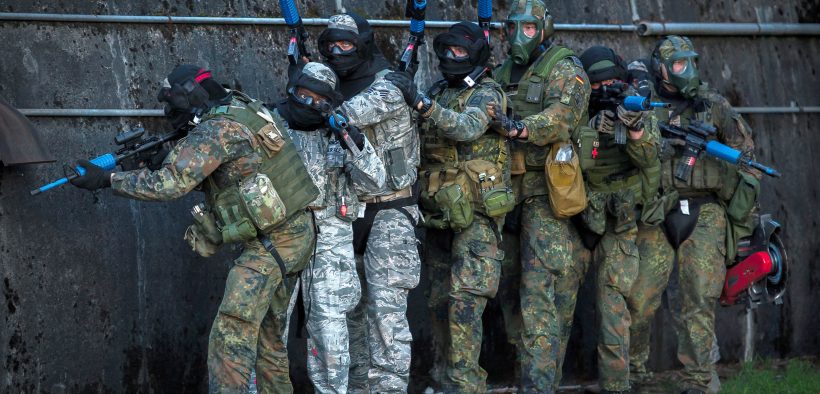US-NATO Military Alliance Continues Confrontation Along Russia’s Borders

“In the context of NATO, the United States [has deployed] around 150 nuclear weapons in Europe, in particular B61 free-bombs, which can be [delivered] by both US and Allied planes.”
(By Brian Cloughley, Strategic Culture Foundation) The Pentagon and its sub-office in Brussels, HQ NATO, in its new billion dollar building, are intent on maintaining military pressure around the globe. The US itself is much more widely spread, having bases tentacled from continent to continent, with the Pentagon admitting to 514 but omitting mention of many countries, including Afghanistan, Syria and Somalia.
Independent researchers came up with the more realistic total of 883 bases, and examination of the current US defense budget shows that the Pentagon’s spending priorities are far from modest in regard to spreading its wings, hulls and boots-on-the-ground to maintain military domination by what Trump calls“the greatest and most powerful Nation on earth.” To this end its vast military spending program includes:
- increasing the strength of the Army, Navy, and Air Force by almost 26,000;
- building another ten combat ships for $18.4 billion;
- increasing production of the most expensive aircraft in world history, the F-35, costing over eleven billion; and
- upgrading and expanding the triad of nuclear weapons deliverable from air, land and sea.
The US military budget for 2020 is officially $750 billion. According to the Stockholm International Peace Research Institute, total US-NATO military expenditure in 2018 was “$963 billion, which represents 53 percent of world spending.” In striking (no humor intended) contrast, Russia’s entire defense budget was $61.4 billion, its annual outlay having “decreased by 3.5 percent,” which even the most brainwashed western war-drummer would have to agree does not reflect the policy of a nation preparing to invade anybody.
Yet the US-NATO alliance is increasing the number and scope of military maneuvers along Russia’s borders, and announced that “in 2019, a total of 102 NATO exercises are planned; 39 of them are open to partner participation.” The exercises include 25 land, 27 air and 12 maritime-centered groups of maneuvers.
“Partner participation” is a disguised way of saying that non-NATO countries around Russia’s borders have been encouraged to join in all the expensive military jamborees aimed at convincing their citizens they should follow “the greatest and most powerful Nation on earth” in its never-ending conquests.
HQ NATO announced that from 8-22 June military forces of 18 nations took part in the BALTOPS naval maneuvers which involved “maritime, air and ground forces with about 50 ships and submarines and 40 aircraft” in and around the Baltic. The NATO spokesperson said, presumably with a straight face and no hint of the wry amusement felt by independent observers, that “BALTOPS is now in its 47th year and is not directed against anyone.” Sure. And the Easter Bunny just landed on Mars.
In the most recent example of US-NATO confrontation, according to US European Command, “the US Air Force deployed F-35 Lightning and F-15E Strike Eagles to Spangdahlem Air Base, Germany, as part of Operation Rapid Forge under the Department of Defense’s Dynamic Force Employment Concept. Rapid Forge will involve forward deployments to bases in the territory of NATO allies in order to enhance readiness… and are conducted in coordination with US allies and partners in Europe. Rapid Forge aircraft are forward deploying to the territory of NATO allies… The goal of the operation is to increase the readiness and responsiveness of US forces in Europe…”
Then on July 16 Stars and Stripes (a remarkably objective commentator, incidentally) reported that the Rapid Forge strike aircraft had been sent to Poland, Lithuania and Estonia “in a test of the service’s ability to quickly deploy air power overseas” These aircraft were specifically deployed to operate as closely as possible to Russian airspace.
The maneuvers are part of ongoing refinement of the Pentagon’s new Dynamic Force Employment strategy “which is focused on using more unpredictable deployments to demonstrate military agility to possible adversaries.” This concept involves “a shift away from traditional six-month naval deployments to a flexible system that can involve shorter but more frequent stints at sea. And in March, the Army dispatched 1,500 soldiers from Fort Bliss, Texas, to Germany and onward to Poland in one of the service’s largest snap mobilizations to Europe in years.”
It was intriguing that the surge in US-NATO military deployment confrontation occurred at the same time it was revealed that the US has been storing nuclear weapons all over Europe for years. Most analysts knew this, although nothing had been admitted, but, as noted in the brilliant BBC TV satire Yes, Minister by the lead character: “First rule in politics: never believe anything until it’s officially denied.”
As the Washington Post reported, “A recently released — and subsequently deleted — document published by a NATO-affiliated body has sparked headlines in Europe with an apparent confirmation of a long-held open secret: some 150 US nuclear weapons are being stored in Belgium, Germany, Italy, the Netherlands and Turkey.” The moment a “NATO official” announced that “we do not comment on the details of NATO’s nuclear posture… this is not an official NATO document,” it was obvious that the deleted details given in the document must be accurate. And now many questions must be answered. For example: under whose guard are these weapons held? Are officials, politicians and military personnel of host countries permitted access to US nuclear storage facilities? What are the nuclear readiness states, and are the host nations informed of these? And it would be very interesting to know if US practice deployments involve nuclear bombs and missiles.
One of the most important aspects of the nuclear bases saga is the likely connection between these US weapons and this year’s US-NATO military maneuvers. The ‘Rapid Forge’ deployments to Russia’s borders involve F-35A and F15E strike aircraft, and Lockheed Martin tells us that “once air dominance is established, the F-35 converts to beast mode, carrying up to 22,000 pounds of combined internal and external weapons.” Similarly, the F-15E is now capable of delivering B61-12 nuclear bombs.
As reported by the Belgian daily De Morgen (in English in the Brussels Timeson 16 July), the document stated that “In the context of NATO, the United States [has deployed] around 150 nuclear weapons in Europe, in particular B61 free-bombs, which can be [delivered] by both US and Allied planes.” But we can be certain that the citizens of the countries concerned, or of any of the other NATO nations, will never be told on what terms the United States is storing nuclear weapons in their countries and what international developments might govern their use.
Presumably it is the President of the United States who will give approval for release of the nuclear bombs being stored in six of the US bases in Belgium, Germany, Italy (2), the Netherlands and Turkey — but is he going to seek agreement from the governments of these countries to use these weapons? It is far from certain that there would be concurrence on the part of Turkey, for example, whose relations with Trump Washington are extremely precarious.
What would happen if President Erdoğan objected to an obviously indicated US intention to convert the USAF’s F-35s to “beast mode”, loading B61 nuclear bombs at Incirlik airbase?
Nobody knows.
And nobody knows if all these US-NATO martial fandangos in the skies around Russia’s borders involve test deployment of strike aircraft in “beast mode”, as nuclear attack preparedness is so aptly described by Lockheed Martin, that prominent member of Washington’s Military-Industrial Complex.
Estonia, Latvia, Lithuania and Poland seem to be delighted that US-NATO is continuing to confront Russia by flying nuclear strike aircraft in their airspace. But have they really thought all this through?




















This is what Americans should be seeing from mainstream U.S. media — the truth!
After the collapse of the Soviet Union and “the end of the Cold War”, NATO (i.e., USA and followers), instead of relaxing into a peaceful status quo with the Russian Federation (whose natural-resources wealth was been looted in the name of “privitization”), aggressively recruited in the following years all of the eastern European countries bordering on Russia. Russia could not allow the Crimea, which is ethnically, culturally, and historically Russian, was “given to Ukraine by Kruschev only in 1954, and hosts Russia’s sole warm-water port, to be taken in by NATO NATO predictably forced Russia’s annexation of Crimea.
Readers, take heed of the author’s credentials:
Brian CLOUGHLEY
British and Australian armies’ veteran, former deputy head of the UN military mission in Kashmir and Australian defense attaché in Pakistan